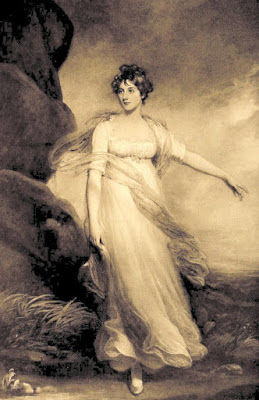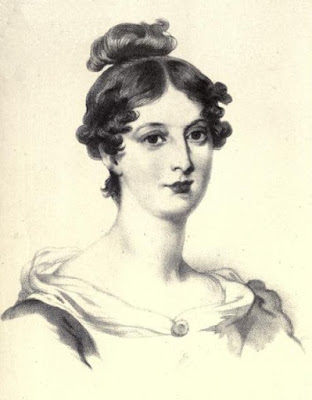 |
| Margaret Mercer Elphinstone by John Hoppner in John Hoppner RA by WD McKay and W Roberts (1909) |
Profile
Margaret Mercer Elphinstone (12 June 1788 – 11 November 1867), later Baroness Keith, Lady Nairne and Comtesse de Flahault, was an intimate friend of Princess Charlotte of Wales and a society hostess.
Early years
Margaret Mercer Elphinstone was born on 12 June 1788, the only child of Admiral George Keith Elphinstone, Viscount Keith (1746-1823), and his first wife, Jane Mercer. Margaret’s mother died in 1789, but Lord Keith did not remarry until almost twenty years later, when he wed Hester Maria Thrale (1764-1857), the eldest daughter and heir of Henry and Hester Thrale, on 10 January 1808.
Princess Charlotte's friend
 |
| Princess Charlotte of Wales from the Autobiography of Miss Cornelia Knight, lady companion to the Princess Charlotte of Wales (1861) |
Margaret, often referred to as Miss Mercer in contemporary documents, became a close and influential companion of Charlotte, Princess of Wales. According to Princess Charlotte’s lady companion, Cornelia Knight, the Princess ‘constantly communicated’ with Margaret.1
Princess Charlotte’s biographer Coote agreed, stating:
The amiable Miss Elphinstone enjoyed her particular confidence and was continually employed by her to execute her several benevolent commissions.2
Princess Charlotte’s relationship with Margaret was probably encouraged by her father. In 1813, some of the details of the supposedly secret 'Delicate Investigation' into the alleged adultery of Princess Charlotte’s mother, Princess Caroline of Wales, became common knowledge. Princess Charlotte was inclined to take her mother’s part against her father, as did most of the public.
Some people believed that Margaret was being used by the Prince Regent to turn Princess Charlotte against her mother. Cornelia Knight wrote:
 |
| Princess Caroline of Brunswick from Huish's Memoirs of her late royal highness Charlotte Augusta (1818) |
About this time Miss Mercer Elphinstone came to Town, and Princess Charlotte wrote to ask the Regent’s permission for seeing her; which was granted. It was evident that this had been arranged beforehand, and that the conditions were that Miss Mercer, who had more influence than any one with Princess Charlotte, should open her eyes to her mother’s imprudence, and break the confidential intimacy between them.3
 |
| George IV by Sir Thomas Lawrence (1816) Photo © RegencyHistory Painting © NPG London |
The accusations of duplicity did not go away. In January 1815, Cornelia Knight wrote:
Miss Mercer Elphinstone has been allowed to visit Princess Charlotte since her return from Cranbourne, and is in constant and undisturbed correspondence with her.
Miss M. is also accused by many of playing a double part. I believe her to be desirous of governing Princess Charlotte without a rival, but I cannot think she would deal treacherously by her, though she may not be aware of the use made of her by her uncle, Mr Adam, who is the Prince’s Chancellor for the Duchy of Cornwall and is supposed to be devoted to the Duke of York. Miss Mercer is in her politics strongly attached to the Opposition, and very intimate with many of them.4
Cornelia Knight was not always complimentary about the influence that Margaret had on Princess Charlotte, but she did write that it was natural that people were suspicious of her because
… it is to be remembered that Miss Mercer is an heiress, and very clever, and will, therefore, always excite jealousy.4
It has been suggested that Margaret wanted to marry the Duke of Devonshire. Cornelia Knight wrote:
Followed by all the mothers and all the misses in London, because he was the yet unmarried Duke of Devonshire, it is probable that he might wish to be liked for himself alone, and this must be the case if Princess Charlotte liked him. His ambition, also, might be roused, and he might, and perhaps unfortunately did, feel really attached to her. A good young man, of a benevolent heart, moderate abilities, and romantic turn (which I understand was the case with him), might easily fall into such a snare. He was very attentive, and Princess Charlotte’s friends were, almost all, very intimate with him. Miss Mercer Elphinstone was supposed to like him, to wish to marry him, and to be playing a deep game, so that when he was disappointed of Princess Charlotte, he might take her, out of gratitude for her good offices. This ill-natured story was too ridiculous to be believed; for if Miss Mercer wished to marry him, she could not at the same time wish to encourage his attachment to a beautiful young Princess of seventeen, who was generally thought the handsomest woman in the ball-room (for dress became her particularly), and who must, at all events, eclipse a woman of twenty-eight, whose great fortune would be no attraction to the Duke.5
Although she disbelieved the rumours, Cornelia Knight recorded two newspaper reports that were printed in the Morning Chronicle in May 1815. The first, published on 11 May announced:
We have great pleasure in announcing that the marriage is settled between the Duke of Devonshire and Miss Mercer, daughter of Lord Keith. It is to take place next week.
The following day, a second newspaper report stated:
We are desired to contradict, from authority, the report of the Honourable Miss Mercer Elphinstone’s marriage with the Duke of Devonshire.6
Princess Charlotte’s wedding anniversary
Margaret maintained her friendship with the Princess after her marriage to Prince Leopold. She was one of a select party invited to Claremont for a dinner and concert to celebrate their first wedding anniversary on 2 May 1817. Princess Charlotte was pregnant and had determined ‘to abstain in future from all crowded assemblies.’7
 |
| Claremont from Select Illustrations of the County of Surrey by GF Prosser (1828) |
On 20 June 1817, Margaret married a French nobleman, Auguste Charles Joseph, Comte de Flahault de la Billardrie, in Edinburgh. Auguste had been an aide-de-camp to Napoleon Bonaparte. After Napoleon’s fall, he came to Britain, where he had spent part of his youth.
Margaret and Auguste had five daughters whilst living in Perth, Scotland: Emily Jane (1819), Clementina Hortense (1821), Georgiana Gabrielle (1822), Adele Elizabeth Josephine (1824), and Sarah Sophia Louisa (1825). Emily married Henry Petty-Fitzmaurice, 4th Marquess of Lansdowne, and Georgiana married Jean Charles Marie Felix, Marquis of La Valette. Clementina and Adele died young and Sarah did not marry.
Auguste and Margaret moved to France in 1827 and Auguste was accepted back into the French government, as ambassador to Rome, Vienna and St James’s, before becoming chancellor to the Legion of Honour.
Baroness Keith and Lady Nairne
Margaret became Baroness Keith in the Irish and UK peerages in 1823 on the death of her father, and succeeded her cousin as Lady Nairne in 1837. The two baronies of Keith became extinct on Margaret’s death, but her eldest daughter Emily, Marchioness of Lansdowne, succeeded her as Lady Nairne.
Margaret was a well-known society hostess in Paris, where she died on 11 November 1867. She was buried at Tulliallan Castle in Perthshire, Scotland.
Notes
(1) From Knight, Cornelia, Autobiography of Miss Cornelia Knight, lady companion to the Princess Charlotte of Wales volume 1 (1861).
(2) From Coote, J, A biographical memoir of the much lamented Princess Charlotte Augusta of Wales and Saxe Coburg (1818).
(3) From Knight, Cornelia, Autobiography of Miss Cornelia Knight, lady companion to the Princess Charlotte of Wales volume 1 (1861).
(4) From Knight, Cornelia, Autobiography of Miss Cornelia Knight, lady companion to the Princess Charlotte of Wales volume 2 (1861).
(5) From Knight, Cornelia, Autobiography of Miss Cornelia Knight, lady companion to the Princess Charlotte of Wales volume 1 (1861).
(6) From Knight, Cornelia, Autobiography of Miss Cornelia Knight, lady companion to the Princess Charlotte of Wales volume 2 (1861).
(7) Huish, Robert, Memoirs of her late royal highness Charlotte Augusta, Princess of Wales (Thomas Kelly, 1818, London.
Sources used include:
Coote, J, A biographical memoir of the much lamented Princess Charlotte Augusta of Wales and Saxe Coburg (1818)
Coote, J, A biographical memoir of the much lamented Princess Charlotte Augusta of Wales and Saxe Coburg (1818)
Huish, Robert, Memoirs of her late royal highness Charlotte Augusta, Princess of Wales (Thomas Kelly, 1818, London)
Knight, Cornelia, Autobiography of Miss Cornelia Knight, lady companion to the Princess Charlotte of Wales (1861)
Reynolds, KD, Flahault de la Billardrie, Margaret de, suo jure Lady Nairne and suo jure Baroness Keith, and Countess de Flahault de la Billardrie in the French nobility (1788-1867) Oxford Dictionary of National Biography (Oxford University Press, 2004; accessed 19 June 2017)
The Gentleman's Magazine (1868)


Very interesting that a woman could inherit the Barony, even if there were no male heirs.
ReplyDeleteWas this just a Scottish tradition?
Although normally titles went from male to male, some titles were created with a special remainder which allowed women to inherit them. There is a whole list of titles that were inherited by women on Wikipedia: https://en.wikipedia.org/wiki/List_of_peerages_inherited_by_women
DeleteAn informative post Rachel! I've long been curious about the life of Mercer Elphinstone and of the candid friendship with Lord Byron which endured until his exile.
ReplyDeleteThanks. I don't think I even realised that they were particular friends. It is fascinating how you always learn more after you've written a post!
DeleteSo her step-mother's mother was Samuel Johnson's Mrs Thrale? I wonder whether they had any dealings.
ReplyDeleteQuite possibly, although Margaret may have been among those who disapproved of Hester Thrale's second marriage.
DeleteHello Rachel
ReplyDeleteThanks for the information, it is very much appreciated.
My wife has a miniature brooch that belonged to Lady Nairne. The portrait is of Lady Lovelace ( Ada, Byron’s only child)
We are trying to find out more about it and would appreciate any direction you may be able to give us.
Possibly you could contact us at pattersonresa@gmail.com
Thank you
Regards R